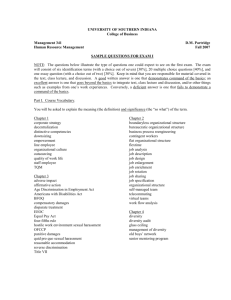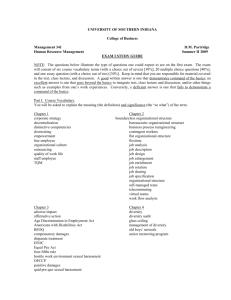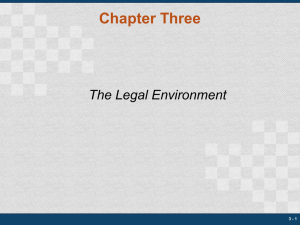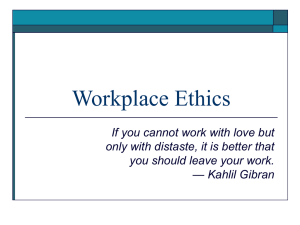government and ethics in the employment relationship
advertisement
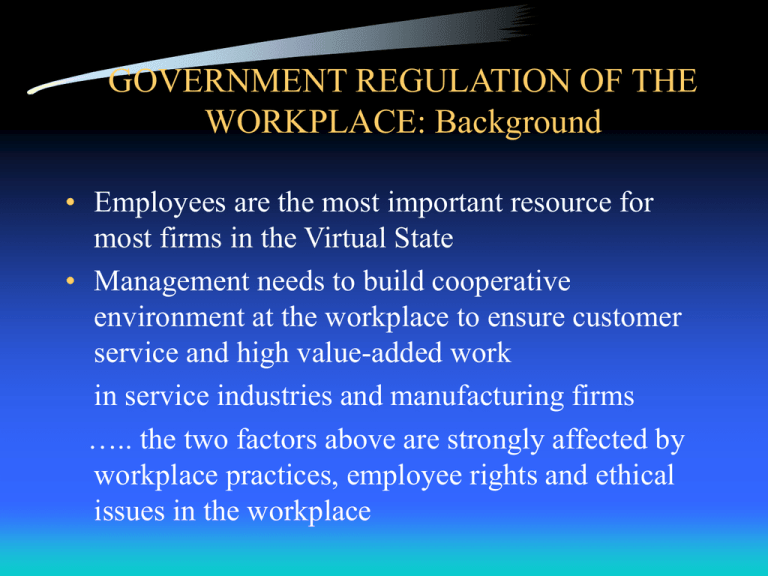
GOVERNMENT REGULATION OF THE WORKPLACE: Background • Employees are the most important resource for most firms in the Virtual State • Management needs to build cooperative environment at the workplace to ensure customer service and high value-added work in service industries and manufacturing firms ….. the two factors above are strongly affected by workplace practices, employee rights and ethical issues in the workplace TOPICS/ISSUES WE WILL REVIEW: (1) EMPLOYEE RIGHTS -- HISTORY & LAWS (2) EQUAL EMPLOYMENT OPPORTUNITY * Nearly 1/4 of all workers are minorities, 1/2 are women * 85% of new workers 1990-2005 will be female or minority (3) SEXUAL HARRASMENT (4) AFFIRMATIVE ACTION (5) “PARADIGMS” OF MANAGING DIVERSITY EMPLOYEE RIGHTS: U.S. LAWS • Courts focus on “fairness” and “implied obligations” of employment • In addition to legal standards, moral standards govern the employment relationship • Workplace rules and regulations are an example of how moral and ethical standards can become law EQUAL EMPLOYMENT OPPORTUNITY TITLE VII OF THE 1964 CIVIL RIGHTS ACT • Prohibits employment discrimination on the basis of race, color, gender, religion or natural origin • Applies to employers with more than 15 employees • Meant to prevent employment policies with disparate impact on particular “protected” groups EQUAL EMPLOYMENT OPPORTUNITY • Age Discrimination in Employment Act of 1967 --prohibits age discrimination against individuals who are 40 years or older • Title 1 of the American Disabilities Act of 1990 prohibits employment discrimination against qualified individuals with disabilities EQUAL EMPLOYMENT OPPORTUNITY (CONTINUED) • Equal employment opportunity may also apply to grooming rules, physical requirements and information about an individual’s past (again, these can have disparate impact on different groups, e.g., American Airlines and flight attendants weight rules) EQUAL EMPLOYMENT OPPORTUNITY RELEVANT INSTITUTIONAL ARENAS * Equal Employment Opportunity Commission -- enforces the federal laws that prohibit employment discrimination --files cases (lawsuits) against companies brought to their attention --requires reporting on employment by race, sex and national origin -- monitors firm compliance INSTITUTIONAL ARENAS (continued) * Courts --”hear” and decide cases * State Commissions, e.g., MA Commission against discrimination, NH Human Rights Commission -- “remedies” include mandated changes in practices and penalties including damages & punitive “awards” * Federal class action lawsuits have more than doubled in last 4 yrs (e.g., Publix, Mitsubishi) --since 1991 fed law allowed for punitive awards and made discrimination easier to prove FIRM DEFENSES IN TITLE VII (EQUAL EMPLOYMENT OPPORTUNITY) (1) Business Necessity --bona fide occupational qualification (2) Practice a result of seniority system -- courts have held up right of seniority (an example of potential conflict over rights) SEXUAL HARASSMENT • Form of unlawful sex discrimination that are made a condition of employment, that interfere with work performance, or that create a hostile work environment • Includes --unwelcome sexual advances • --requests for sexual favors • --verbal or physical conduct • ** Employers are responsible for maintaining a workplace free of sexual harassment and they are liable for the unlawful conduct of employees SEXUAL HARASSMENT: CASES IN THE NEWS • ASTRA USA $10m to settle a sexual harassment lawsuit by EEOC. ASTRA maintained a sexually hostile work environment and retaliated against employees who reported such behavior,including quid pro quo harassment. • MITSUBISHI --Court ruled that EEOC could bring class action sexual harassment suit against the company • UNH --Professor Silva “belly dancing is like Jello on a plate with a vibrator under the plate” -- ordered to apologize and undergo counseling --sued and won, as court claimed UNH violated his 1st ADM rights • ** “WIDE” DIFFERENCES IN INTERPRETATIONS AND OPINIONS ON SEXUAL HARASSMENT AFFIRMATIVE ACTION: ANOTHER CONTROVERSIAL AREA OF EMPLOYMENT LAW • PRESIDENT LYNDON JOHNSON 1965, SIGNED EXECUTIVE ORDER 11246 WHICH • Requires employers doing business with the Federal Government to develop affirmative action plans to assure equal employment opportunity • Applies to: Federal Government contractors, suppliers, grantees (e.g., UNH) • Affirmative Action is a conscious attempt to realize equal opportunity AFFIRMATIVE ACTION (continued) • Includes steps to remedy the effects of past discrimination and allows preferential treatment for individuals in protected classes • Affected firms must adopt recruiting policies that ensure that minorities and females are included in the pool of job candidates • Two ethical bases for affirmative action • compensatory justice (for past injustices) • equality of opportunity Conditions under which “reverse discrimination” resulting from AA is legal (1) AA needs to be a formal systematic program -- employer cannot discriminate against nonminorities on an isolated, ad hoc basis (2) Must be temporary, until “reasonable”minority hiring goals are achieved (3) Program can not completely bar the hiring of non-minority workers “REVERSE DISCRIMINATION” (continued) (4) Must be based on either past discrimination or simply under-utilization of minorities or women in the workplace (e.g., UNH) (5) Can not force employer to hire or promote unqualified workers UNIVERSITY OF TEXAS LAW SCHOOL HOPWOOD V. TEXAS CASE (‘96) • US fifth district court ruled that law school could not use race as a factor in admission • Case filed by 4 whites who had been denied admission • Fall 1997 class of 800 students admitted, only 6 are Black and 18 Mexican-Amer. compared to 65 and 70 fall 1996 • To ensure diversity Texas University System is now using economic status and class rank in undergraduate admission ISSUES -- EMPLOYMENT OPPORTUNITY AND AFFIRMATIVE ACTION (1) DIFFERENT PERCEPTIONS ON ISSUE • 60% of whites feel that people of color have same opportunities as whites, while 70% of blacks feel that people of color do not have same opportunities (2) REVERSE DISCRIMINATION • less than 100 cases • (3) “GLASS CEILING” • white men 43% of workforce, but 95% of senior management, only 6% of directors of the top 500 corporations are female “PARADIGMS” FOR MANAGING DIVERSITY • FAIRNESS -- compliance with laws, color and gender blind ideal practiced, assimilation, treat all employees the same • ACCESS -- acceptance of differences, match the demographics of the organization to those of critical consumer or constituent groups, use diverse workforce to champion niche marketing (LEVI STRAUSS EXAMPLE) • LEARNING -- create “safe” places for diverse employees to be themselves and contribute to the organization in unique ways, recognize and benefit from differences among employees
